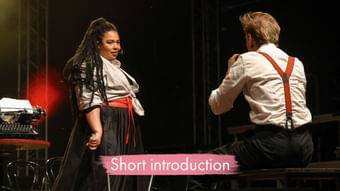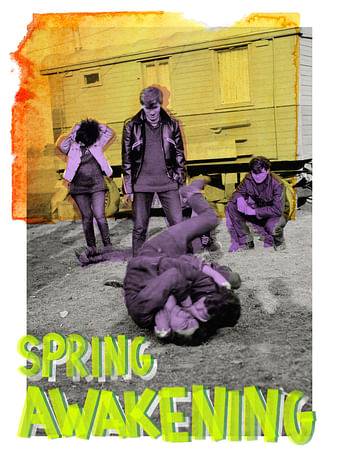“I was already warned that I would have to fear for my life,” Carmen declares—foreseeing her own doom—in the finale of Bizet’s “opera of all operas” (as Nietzsche once called it). A few minutes later, she is dead, stabbed by the man who was still her lover only moments before, the soldier Don José. The team behind Killing Carmen—Nils Strunk, Lukas Schrenk, and Gabriel Cazes—asked themselves from which perspective this opera, after its many adaptations (including pop-cultural ones) throughout the 20th century, could be retold once again. These three exceptional artists, who for years have devoted themselves to daring and high-energy reinterpretations of the classics, continue the opera’s story: What happened after Carmen’s murder? What void did she leave behind?
Killing Carmen takes place 13 years after the events of the opera: Don José has been imprisoned all this time and is now to be executed by hanging. On the day of reckoning, various characters return to Lillas Pastia’s tavern and renegotiate their differing memories: one of them has become complicit, another still clings to a former love, a third can look back on a life fully lived—but perhaps only because she was not “the chosen one” back then… Where do the characters stand 13 years later? And what meaning do their partly glorified, colorful, and emotionally charged past experiences still hold for them?
In a fast-paced reworking of both music and text, Nils Strunk, Lukas Schrenk, and Gabriel Cazes weave together flashbacks and continuations. Bizet’s famous melodies meet a wide range of musical styles—from jazz, flamenco, musical theatre, and pop to country, chanson, and much more. The stylization of the classic Carmen as the notorious femme fatale has shaped the opera’s reception history. Yet this also always harbors the danger of a subtle reversal of perpetrator and victim: whether through romanticizing or demonizing, Carmen is, almost unconsciously, assigned a share of the blame for her fate. But is that truly what Bizet and his librettists Halévy and Meilhac intended to convey?
“Free I was born, free I shall die,” Carmen proclaims in the finale of the original. Does Carmen die because of the way she chooses to live? And does freedom itself perhaps die with her? Every person carries a world within. When a person is killed, that world dies too.
Cast
- Stage direction
- Nils Strunk
- Stage direction
- Lukas Schrenk
- Set and costume design
- Anne Buffetrille
- Set and costume design
- Lara Katharina Regula
- Dramaturgy
- Magdalena Hoisbauer
- Lighting design
- Sascha Zauner
- Musical direction
- Gabriel Cazes
- Carmen
- Katia Ledoux
- Don José
- Anton Zetterholm
- Escamillo,Toreador
- Stefan Cerny
- Micaëla, Dancaïro
- Julia Edtmeier
- Morales
- Florian Carove
- Drums / Percussion
- Jörg Mikula
- Bass / Gitarre / Harmonika / Gesang
- Bernhard Moshammer
- Gitarre / Cello / Gesang
- Hans Wagner
- Cello / Gesang
- Rina Kaçinari
Photos and Videos
For all those who use a screen reader, a description of the visual aspects of the performance (set design, costumes...) follows here instead of the photo gallery.
Killing Carmen takes place on the forestage, i.e. not on the Volksoper's main stage, but on the raised orchestra pit, where a band with a piano and other musical instruments is located on the left. On the right are a few chairs and tables, the whole thing representing the bar of Lillas Pastia, a somewhat run-down dive where the characters meet. In the background, the scene is bordered by a black curtain. Apart from musical instruments, tables and chairs, there is no stage set; different lighting moods create different atmospheres. The light in the present is cool and bluish; when the characters remember the events of 13 years ago, when the story between Carmen and Don José began, the light becomes warmer, redder, more sensual. Carmen's performances in particular are accompanied by dramatic red light. The costumes are kept simple at first: Dark coats and hats create a Western atmosphere. When the characters remember their past, the costumes become more colorful: A dress with red accents, then later a kind of white flamenco dress for Carmen, a torrero uniform for Escamillo, soldiers' jackets in blue and red for Don José and Moralès, for example. The scene with the smugglers takes place at the front right of the stage; a carpet is rolled out for this scene. Crates stacked on top of each other, together with small lanterns, create the atmosphere of a smuggler's hideout.
Articles from our Weborello
"Clever, witty and moving": Press reviews of Killing Carmen
"Lively and clever, spirited and moving," read one review of the acclaimed premiere of Killing Carmen.

Introducing: The Dream Team
From the ensemble to the interns, from journalists to our artistic director—without exception, everyone loves the team behind Killing Carmen! Nils Strunk and Lukas Schrenk, together with the French musician Gabriel Cazes, are creating a multilingual and multi-musical reinterpretation and continuation of Bizet’s Carmen.

Killing Carmen rocked the Donauinselfest!
The Donauinselfest is one of the largest open-air festivals in the world. The pre-opening on June 19, 2025, featuring a sneak preview of our production Killing Carmen, was a complete success. Countless audience members were thrilled and cheered. You weren’t there? Presale for the October performances at the Volksoper has already started, so: Don’t miss out!
































.jpg)

_RET.jpeg)
